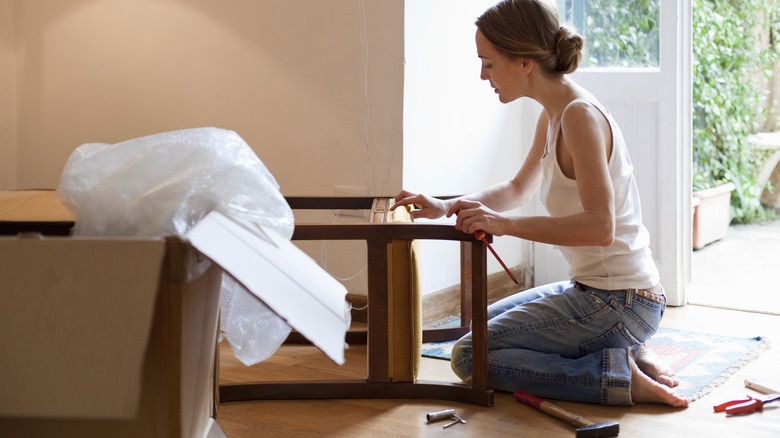Why Dental Tools Are The Ultimate Trick For Fixing Up Furniture
We may receive a commission on purchases made from links.
Wondering how to get started flipping furniture or just want to deep clean your own pieces? Aside from learning how to prep furniture before refinishing it, you'll also need to create a go-to toolkit to make your job easier. Now, the thought of dental tools in your mouth may make you cringe, but putting them to use as a cleaning tool can make you do a happy dance. Why? Because furniture cleaners will get the surface grime and buildup off your furniture, but most won't do a great job at detailing the crevices and carved areas. This is where dental tools shine.
You don't need to spend hundreds of dollars on professional dental tools to clean furniture. The G.CATACC dental tool kit from Amazon has various dental tools for under $20 that will serve all your furniture detailing needs. Each of the tools can help you get deeper into dirty crevices to remove loosened wax, paint, and veneer. If you want to successfully flip thrifted or salvaged furniture, cleaning it well is essential to lay the foundation for your upcycling projects. Paying attention to the small details can help you fetch top dollar for your efforts. For your own furniture, deep cleaning can preserve the beauty of your pieces and keep dust and gunk from building up inside crevices.
How to use dental tools to upcycle your furniture
Depending on how dirty the furniture is, you'll need to start with a good degreaser. Don't grab your Dawn dish detergent for this job, because dish soap isn't strong enough to remove built-up grease. For wood furniture, it's best to use an all-purpose degreaser made up of distilled white vinegar, baking soda, and water. If you're stripping the furniture, you can skip this step because strippers take everything off, from grease to paint. Once clean or stripped, it's time to do the detailing work using your dental tools.
If you've got softened grease or paint stuck in the crevices, start with the gum cleaner or tartar scraper to gently scrape away all the goop. After getting the big stuff out of the cracks, use the sickle scaler or dental pick's pointy tips to get deep into small spaces or carvings. Use a gentle touch, you don't want to gouge the wood. For larger areas and particularly delicate pieces with veneer, use the tartar scraper. You'll hopefully be able to remove stuck-on veneer without scarring the wood underneath. Using a tiny tool to remove the veneer will increase the time you'll put into removing it, but not taking the time to prep properly is one of the biggest mistakes you can make when trying to flip a piece.
